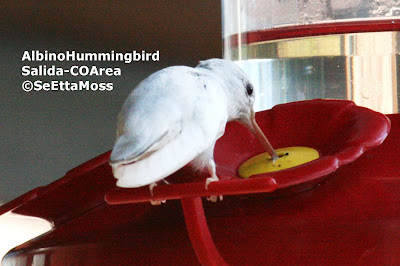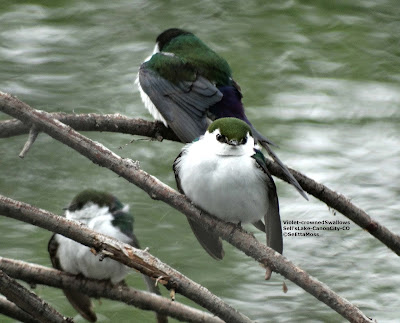Salida white hummer: still around
I found out this past week that the probable albino hummingbird that had visited a feeder near Salida, CO was still around and coming to a neighbor's feeder. (Let me add a thank you to Susan Tweit of Salida for sending me a tip about this bird). The feeder owner, Helen Brieske, was most generous in her invitation to sit on her deck to wait near the feeder. I was delighted that the bird came in to feed several times and also perched in a nearby pine tree for several minutes at a time so I was able to get photos that could be cropped to show it pretty close-up.
The white feathering was truly dazzling. The dark that is seen through the white feathers appears to be the skin which is darkened by the flood of blood vessels beneath. These photos show that the bill is very pink, just as was shown in the original photos I posted, though almost translucent as shown in the photo on the right. In these photos the legs are visible as well as the feet, both of which are whitish to pinkish in coloration. That would be from the blood flowing through the veins as I understand it. When I enlarge the photos as far as possible the toenails also appear pinkish. The eye, however, does not appear to have red or pink in it so what I saw in the very enlarged original photos was likely the reflection from the red feeder.
There appears to be some disagreement on exactly what is a albino and what is a leucistic hummingbird. I summarized the designations defined by Cornell University on my first post about this bird on the Birds and Blooms blog. Using this research this hummer would meet the criteria for an incomplete (or partial) albino as it has white feathers and the pigment missing in bill, legs and feet but it has a dark eye. However, I am told that identification can only be confirmed with a hummingbird in hand so this will remain a probable partial albino. SeEtta





Comments